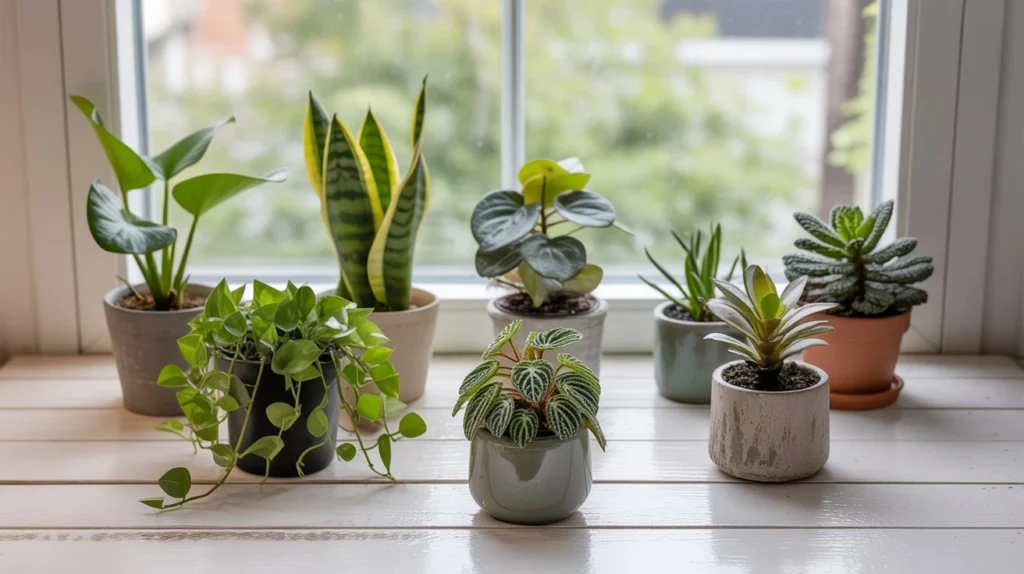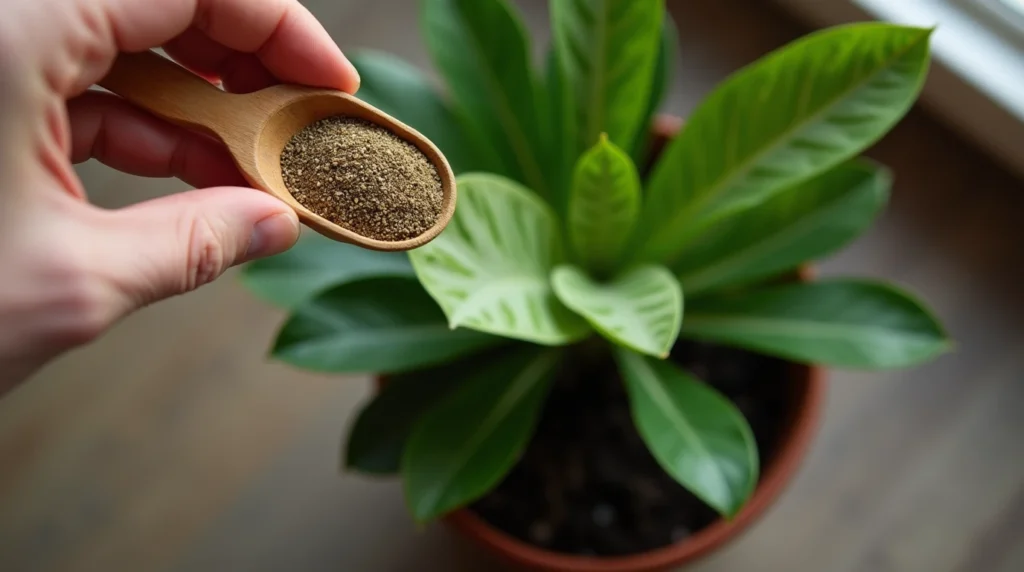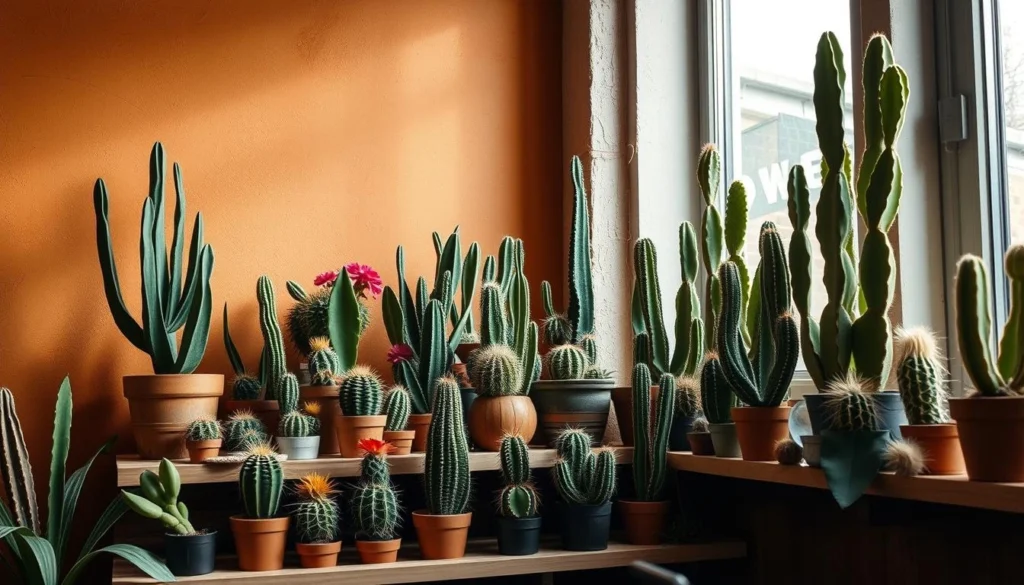
Did you know that indoor cactus plants can purify the air and boost your mood? They’re great for busy people or those new to plants.
Cacti bring a desert vibe to your home, creating a calming atmosphere. They’re perfect for brightening a room or adding greenery. The best indoor cactus plants are a great choice.
They look good and are easy to care for. This makes them ideal for anyone wanting to brighten their space.
Table of Contents
Why Cacti Make Excellent Houseplants
Looking for a low-maintenance yet stylish home addition? Cacti are a great pick. They thrive indoors with minimal care, perfect for those with little time.
Low-Maintenance Appeal for Busy Plant Parents
Cacti are very forgiving if you forget to water them. They need less water than other plants and can go weeks without it. This makes them ideal for busy people.
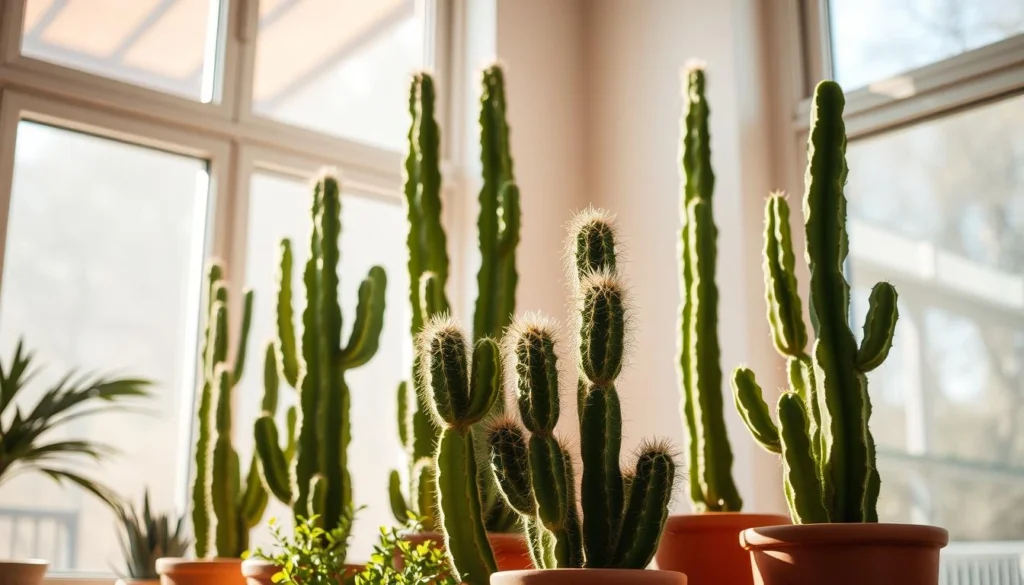
Health and Aesthetic Benefits of Indoor Cacti
Cacti also bring health and beauty to your home. They purify the air and release oxygen, making your space healthier. Plus, they come in many shapes, sizes, and colors, adding style to any room. Here are some key benefits of having cacti indoors:
| Benefits | Description |
| Air Purification | Cacti remove pollutants from the air, improving indoor quality. |
| Aesthetic Appeal | Cacti add visual interest with their varied shapes, sizes, and colors. |
| Stress Reduction | Studies show that indoor plants like cacti can reduce stress. |
How to Choose the Perfect Cactus for Your Home
Finding the right cactus for your home is easy if you know what to look for. Think about your home’s conditions and how they match the needs of popular indoor cactus varieties.
Assessing Your Light Conditions and Space
Check your home’s light and space before getting a cactus. Some need lots of direct light, while others prefer softer, indirect light. Make sure the spot you choose has enough room for the cactus to grow. Measure the space and think about the cactus’s full size to prevent it from getting too big.
Considering Growth Habits and Mature Size
Cacti grow differently and vary in size. Some stay small, while others can grow big. Look for the best indoor cactus plants that fit your space and growth patterns.
Matching Cacti to Your Experience Level
If you’re new to cacti, start with easy-to-care-for types. More experienced people can choose from a wider range. Think about your ability to meet the cactus’s needs, like watering and fertilizing.
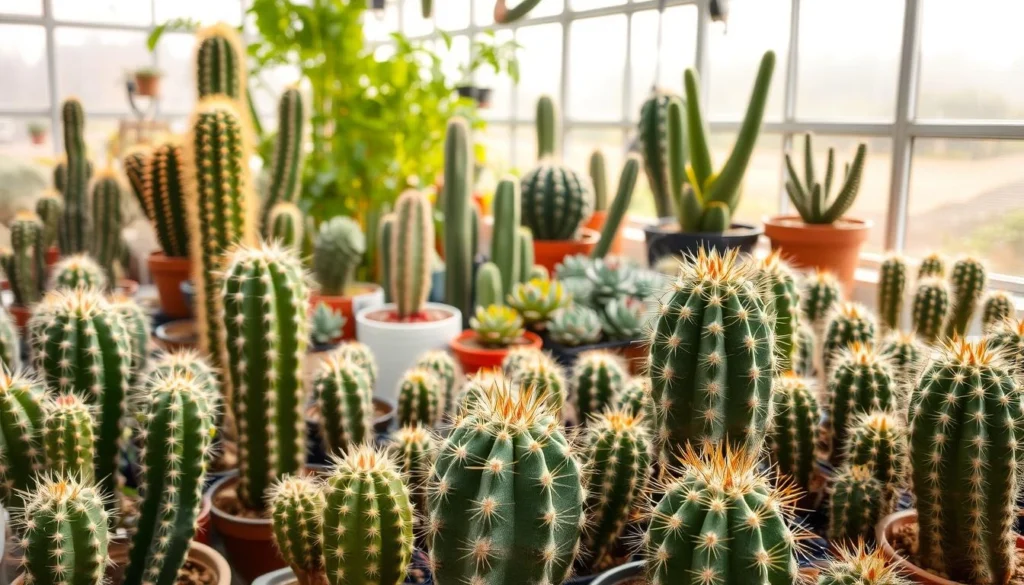
- Assess your home’s light conditions.
- Consider the mature size of the cactus.
- Match the cactus to your care experience.
By following these tips, you can find the perfect cactus to beautify your home.
10 Best Indoor Cactus Plants for Every Space
Indoor cacti come in many shapes and sizes, fitting any space or taste. Whether you’re new to plants or have a green thumb, there’s a cactus for you.
Christmas Cactus (Schlumbergera)
The Christmas Cactus is a favorite for indoor gardens. It blooms brightly around the holidays.
Appearance and Flowering Habits
It has flat stems and blooms in pink, red, or white.
Ideal Placement and Basic Care
Place it in bright, indirect light. Water it sparingly, letting the soil dry a bit between waterings.
Bunny Ears Cactus (Opuntia microdasys)
This cactus is easy to spot because of its round, fuzzy pads that look like bunny ears.
Distinctive Features and Growth Pattern
It grows slowly and can reach up to 3 feet tall.
Handling Precautions and Care Requirements
Be careful of its small, hair-like spines. Also, make sure it has good air flow to avoid fungal infections.
Moon Cactus (Gymnocalycium mihanovichii)
The Moon Cactus is famous for its brightly colored top grafted onto a rootstock cactus.
Colorful Varieties and Structure
It comes in bright colors like red, orange, and yellow.
Special Care Considerations
It needs careful watering to avoid rot, paying extra attention to the graft union.
Barrel Cactus (Echinocactus and Ferocactus)
Barrel Cacti are known for their round shape and long, sharp spines.
Distinctive Round Shape and Spines
They can grow large and add a striking touch to any room.
Light and Watering Needs
They need full sun to partial shade and should be watered infrequently, making them drought-tolerant.
Star Cactus (Astrophytum)
The Star Cactus is admired for its unique, star-shaped appearance.
Unique Star-Shaped Appearance
It grows slowly and stays small, perfect for small spaces.
Optimal Growing Conditions
It prefers well-draining soil and full sun to partial shade.
| Cactus Type | Lighting Needs | Watering Frequency |
| Christmas Cactus | Bright, indirect | Sparingly |
| Bunny Ears Cactus | Full sun to partial shade | Infrequently |
| Moon Cactus | Bright, indirect | Carefully |
Fairy Castle Cactus (Acanthocereus tetragonus)
This cactus is known for its architectural, columnar stems.
Architectural Structure and Growth Rate
It can grow tall and is a striking addition to indoor spaces.
Long-Term Care for Healthy Growth
Provide support as it grows and ensure good air circulation.
Old Lady Cactus (Mammillaria hahniana)
The Old Lady Cactus is covered in fine, white spines, giving it a fuzzy appearance.
Fuzzy Appearance and Flowering Habit
It blooms beautifully around the crown.
Humidity and Temperature Preferences
It prefers moderate humidity and temperatures between 65-75°F.
Rat Tail Cactus (Aporocactus flagelliformis)
This cactus has long, trailing stems that resemble a rat’s tail.
Trailing Growth Habit and Display Options
It’s perfect for hanging baskets or trailing over pots.
Supporting Healthy Trailing Stems
Ensure it has something to trail on and provide bright, indirect light.
Bishop’s Cap (Astrophytum myriostigma)
The Bishop’s Cap is known for its unique, geometric shape.
Geometric Shape and Slow Growth
It’s a slow-growing cactus that can be a fascinating addition.
Preventing Common Issues
Watch for signs of overwatering, such as softening or discoloration.
Pincushion Cactus (Mammillaria)
Pincushion Cacti are small, globular cacti covered in fine spines.
Compact Size and Flowering Habits
They produce beautiful, funnel-shaped flowers.
Creating Optimal Growing Conditions
Provide bright light and infrequent watering for optimal health.
Essential Care Guide for Indoor Cactus Plants
Proper care for your indoor cactus plants is key to keeping them healthy. This ensures they continue to add beauty to your space. By following the right care tips, you can enjoy your cacti for many years.
Watering Techniques and Seasonal Adjustments
Watering is a critical part of cactus care. In the growing season (spring and summer), water when the top inch of soil is dry. In the dormant season (fall and winter), water less, once a month or less, depending on temperature and humidity. Avoid overwatering to prevent root rot.
Light Requirements and Positioning
Most cacti need bright, indirect light. A south-facing window is ideal, but watch out for direct sunlight that can burn them. Some cacti can handle low light, so check their specific needs. Rotate your plants to ensure even growth.
Soil Composition and Potting Best Practices
Use a well-draining cactus mix to avoid waterlogged soil. A mix with perlite, sand, and peat moss works well. Choose a pot that’s slightly larger than the cactus and has drainage holes. Repot every year or two to refresh the soil and provide a larger pot if needed.
Fertilizing and Repotting Schedule
Feed your cacti with a balanced, water-soluble fertilizer during the growing season. Dilute the fertilizer to half strength to prevent root burn. Repot in the spring when the cactus is actively growing. This is a good time to check the roots and trim any damage.
| Care Aspect | Spring/Summer | Fall/Winter |
| Watering | Water when top inch of soil is dry | Reduce to once a month or less |
| Light | Bright, indirect light | Continue bright, indirect light |
| Fertilizing | Feed with balanced fertilizer | No fertilizing |
| Repotting | Repot as needed | Avoid repotting |
Propagating Your Indoor Cactus Plants
If you want to grow more of your favorite cacti, learning about cactus propagation is key. It lets you share or grow your collection. With the right steps, you can create new plants.
Propagation Methods for Different Cactus Types
Each cactus species has its own way of being propagated. Some can be grown through grafting, while others need stem cuttings. Knowing what your cactus needs is vital for success.
Grafting joins a stem piece from one cactus to another’s roots. It’s great for tricky species like the Moon Cactus. But, stem cuttings work well for many, like the Christmas Cactus and Bunny Ears Cactus.
Step-by-Step Guide to Successful Propagation
To grow your indoor cactus plants well, just follow these steps:
- Choose a healthy stem or segment from the parent plant.
- Let the cut end dry for a few days to form a callus.
- Plant the cutting in well-draining soil, and water sparingly until roots develop.
- Give the new plant bright, indirect light and keep the temperature steady.
By following these steps and picking the right method for your cactus, you can have a lush collection of indoor cactus plants.
Read More :
Caring for palm plant indoor : A Guide to Lush Growth
Indoor Bamboo Plant Care Made Blissfully Simple
Conclusion
You now know how to pick and care for the best indoor cactus plants. They can turn your space into a lively oasis. These plants come in different shapes and sizes and need little care.
Choosing from the top indoor cactus plants brings many benefits. They purify the air and add beauty to your space. Whether you’re experienced or new to gardening, these plants will enhance your home or office.
Begin your indoor cactus journey today. You’ll find joy in caring for these amazing plants. With the right care, your cacti will flourish, making your space more beautiful and sustainable.
FAQ
What are the best indoor cactus plants for beginners?
For beginners, Christmas Cactus, Bunny Ears Cactus, and Pincushion Cactus are great. They are easy to care for and hardy.
How often should I water my indoor cactus plants?
Watering frequency varies by cactus type, soil, and environment. Water when the soil feels dry, usually every 7-10 days in summer. Water less in winter.
Can I keep my indoor cactus plants outdoors during the summer?
Yes, many indoor cacti can go outside in summer. But, slowly get them used to sunlight and outdoor air to avoid damage.
How do I fertilize my indoor cactus plants?
Use a balanced, water-soluble fertilizer in spring and summer. Dilute it to half strength to protect the roots.
Why is my indoor cactus plant not flowering?
Cacti need cooler temperatures and less water to bloom. Make sure they get enough light and have a winter rest.
Can I propagate my indoor cactus plants?
Yes, you can propagate many cacti by cutting, dividing, or seeding. Learn the right method for your cactus and follow it carefully.
How do I repot my indoor cactus plants?
Repot when the cactus is too big for its pot. Use a cactus mix and a slightly larger pot. Wear gloves to protect from spines.
Are indoor cactus plants safe for pets?
Most cacti are safe, but their spines can hurt pets. Keep them away from pets. Choose spineless varieties if your pets like plants.
How much light do indoor cactus plants require?
Most cacti need bright, indirect light. Some can handle full sun or low light. Check your cactus’s specific needs for best care.
